Harpoceratinae
Harpoceratinae is an extinct subfamily of cephalopods belonging to the family Hildoceratidae. Ammonites of this subfamily had involute and compressed shells with strong keels. Keel might be rarely missing, but this is considered to be an abnormality. This has been observed both in Cleviceras and Harpoceras and called as genus Monestieria, which is now known to be invalid (into this invalid genus were added also abnormal unkeeled specimens of genus Protogrammoceras). Another example is Pseudolioceras, whose unkeeled specimen was used as type for description of invalid genus Praehaploceras. Oxyconic forms of this subfamily (Polyplectus and Sphenarpites) does not have any keel. Ribs were single, but in some genera also bifurcating with shapes from sigmoidal to falcate. Sometimes, shell can have only striate ribs or is smooth (Sphenarpites and older specimens of Eleganticeras and Ovaticeras). Tubercules are rare. Dimorphism is known in some genera and it is observable mostly in size. Macrochons can be 4, to 6 times larger than microconchs. As an example, macroconchs of Pseudolioceras are more than 150mm in diameter, while adult microconchs are only 35-50mm. There are big size differences even within dimorphs. Specimens ca be 2, or sometimes even 3 times bigger than other specimens of same dimorph.[1]
| Harpoceratinae Temporal range: | |
|---|---|
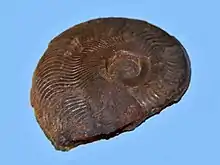 | |
| Fossil shell of Harpoceras subplanatum from Isère (France), on display at Galerie de paléontologie et d'anatomie comparée in Paris | |
| Scientific classification | |
| Domain: | Eukaryota |
| Kingdom: | Animalia |
| Phylum: | Mollusca |
| Class: | Cephalopoda |
| Subclass: | †Ammonoidea |
| Order: | †Ammonitida |
| Family: | †Hildoceratidae |
| Subfamily: | †Harpoceratinae Neumayr, 1875 |
| Genera | |
|
at least 9, see text | |
| Synonyms | |
|
Polyplectinae Venturi, 1981 | |
Genera
At least 9 genera is considered to be members of this subfamily.[1][2] This number can be increased, as some authors might consider valid some genera, which are by other authors considered to be synonyms of these 9. For example, Maconiceras is sometimes listed within this subfamily,[3] while by other authors, it is considered to be a synonym of Harpoceras.[1]
- Cleviceras Howarth, 1992 (sometimes considered as synonym of Eleganticeras)[2][4]
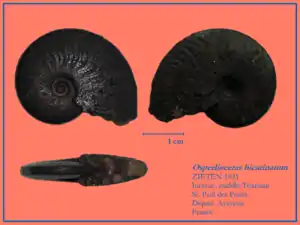
- Eleganticeras Buckman, 1913
- Harpoceras Waagen, 1869
- Osperleioceras Krimholtz and Tazikhin, 1957
- Ovaticeras Buckman, 1918
- Polyplectus Buckman, 1890
- Pseudolioceras Buckman, 1889
- Sphenarpites Spath, 1936
- Taffertia Guex, 1973
- Tiltoniceras Buckman, 1913
Sometimes, more genera is referred to this subfamily, as some authors does not recognize validity of subfamily Protogrammoceratinae.[3][5] Neolioceratoides, which has been included within Protogrammoceratinae and was also considered to be a synonym of Lioceratoides is now member of Hildoceratinae, which is reason why it is not listed below.[6] This would include genera:
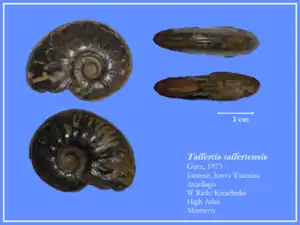
- Protogrammoceras Spath, 1913
- Fuciniceras Haas, 1913
- Lioceratoides Spath, 1919
In 1981 a new subfamily has been erected and named Polyplectinae, which is sometimes considered to be a synonym of Harpoceratinae,[1] but sometimes it is still used as valid taxa.[7] Following genera are part of this subfamily:[8]
- Polyplectus Buckman, 1890
- Praepolyplectus Venturi, 1981 (synonym of Polyplectus)
Distribution
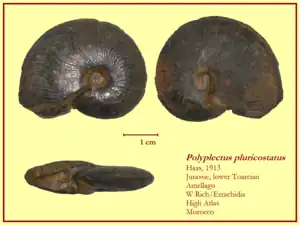
Fossils of this subfamily have been found in the layers of upper Pliensbachian - lower Bajocian age. Distribution for subfamily is worldwide. All genera have been found in northern hemisphere, but only fossils of Harpoceras, Osperleioceras and Polyplectus comes also from southern hemisphere.[1]
Timeline and evolution
If Protogrammoceratinae shall be considered a valid subfamily, then Harpoceratinae might be of polyphyletic origin with at least 2 main lineages, both evolving from Protogrammoceratinae. First one started in upper Pliensbachian (Spinatum zone) when Tiltoniceras evolved from Lioceratoides, or Protogrammoceras. In Toarcian, during lower part of Exaratum subzone of Falciferum zone it evolved into Eleganticeras, which soon gave rise to Cleviceras. Polyplectus evolved from this genera.
Second lineage originated from Protogrammoceras, which has been predecessor for Harpoceras. Three genera evolved from this genus - Osperleioceras (from Harpoceras subplanatum), Ovaticeras (from Harpoceras falciferrum) and Pseudolioceras (probably also from Harpoceras falciferrum). Pseudolioceras is the only known member of this subfamily that lived also in middle Jurassic. Last common ancestor of both these lineages might have been Protogrammoceras that lived in Spinatum zone of Pliensbachian or sooner. Some authors (Knyazev et al., 2007) does not recognize validity of Cleviceras and place its species still in Harpoceras, while they considers Harpoceras falciferrum to be descended from Harpoceras exaratum (in most of recent literature is this species member of genus Cleviceras). Origin of the remaining 2 genera is probably unknown. Taffertia lived in Falciferrum zone of early Toarcian (maybe only in Exaratum subzone). Sphenarpites is known from single specimen that comes from early Toarcian.[1][9][10][11]
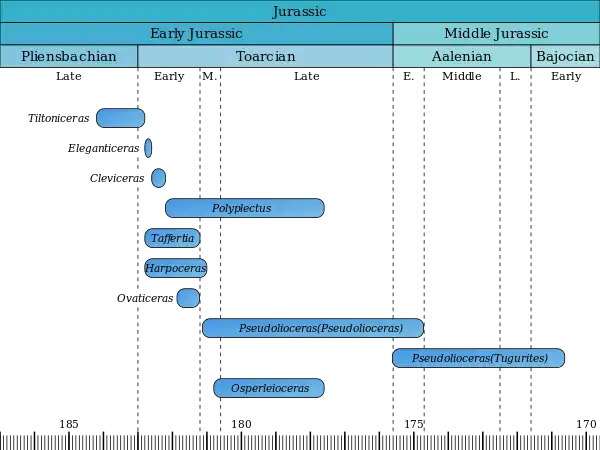
References
- M. K. Howarth 2013. Treatise on Invertebrate Paleontology, Part L, Revised, Volume 3B, Chapter 4: Psiloceratoidea, Eoderoceratoidea, Hildoceratoidea.
- Marc BÉCAUD (2006) LES HARPOCERATINAE, HILDOCERATINAE ET PARONICERATINAE DU TOARCIEN DE LA VENDÉE ET DES DEUX-SÈVRES (FRANCE).
- Bardin Jérémie, Rouget Isabelle, Benzaggagh Mohamed, Theodor Fürsich Franz, Cecca Fabrizio (2015). "Lower Toarcian (Jurassic) ammonites of the South Riffian ridges (Morocco): systematics and biostratigraphy". Journal of Systematic Palaeontology. 13 (6): 471–501. doi:10.1080/14772019.2014.937204. S2CID 129583207.
{{cite journal}}: CS1 maint: multiple names: authors list (link) - CV Ullmann, N Thibault, M Ruhl, SP Hesselbo, C Korte (2014). "Effect of a Jurassic oceanic anoxic event on belemnite ecology and evolution" (PDF). Proceedings of the National Academy of Sciences. 111 (28): 10073–6. Bibcode:2014PNAS..111S0073U. doi:10.1073/pnas.1320156111. PMC 4104856. PMID 24982187.
{{cite journal}}: CS1 maint: multiple names: authors list (link) - Kamata Yoshihito, Mizobe Shin-Ichi, Sato Tadashi (2003). "An Early Jurassic ammonite from a limestone conglomerate in the Kuzu Complex of the Ashio Belt". Paleontological Research. 7 (3): 185–194. doi:10.2517/prpsj.7.185. S2CID 130917025.
{{cite journal}}: CS1 maint: multiple names: authors list (link) - Bardin, J., Rouget, I., & Cecca, F. (2016). The phylogeny of Hildoceratidae (Cephalopoda, Ammonitida) resolved by an integrated coding scheme of the conch. Cladistics.
- Kovács, Z. "Lower Toarcian Ammonitida fauna and biostratigraphy of the Gerecse Mountains (Hungary).—." Fragmenta Palaeontologica Hungarica 29 (2012): 1-48.
- Venturi F, Bilotta M (2008) New data and hypotheses on early Jurassic ammonite phylogeny. Rev Paléobiol 27:859–901
- M. K. Howarth 1992. HILDOCERATIDAE IN THE LOWER JURASSIC OF BRITAIN
- J. Rai, S. Jain 2013. Pliensbachian nannofossils from Kachchh: Implications on the earliest Jurassic transgressive event on the western Indian margin
- В. Г. Князев, Р. В. Кутыгин, О. А. Мельник, 2007. БИОХРОНОЛОГИЧЕСКАЯ ШКАЛА ТОАРА-РАННЕГО БАЙОСА СЕВЕРО-ВОСТОКА АЗИИ ПО ХАРПОЦЕРАТИНАМ (АММОNОЮЕА) (V. G. Knyazev, R. V. Kutygin, O. A. Meľnik, 2007, A Toarcian–Early Bajocian biochronological scale for northeastern Asia, based on Harpoceratinae (Ammonoidea))(in Russian)